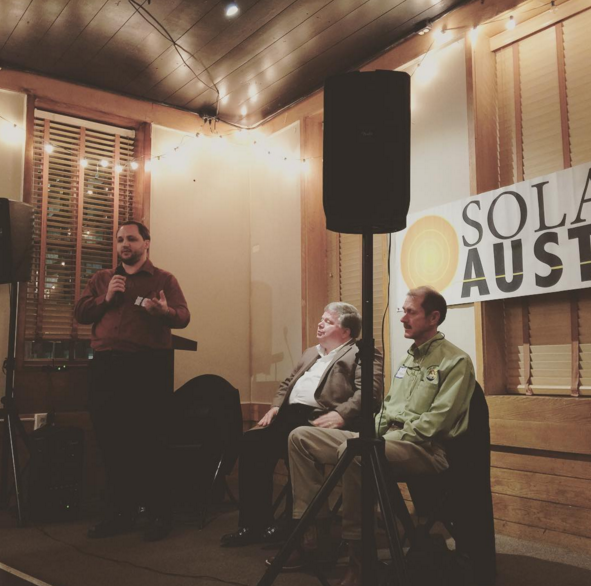Nestled 25 miles north of Austin in conservative Williamson County sits the first city in the United States to officially make the switch to 100 percent renewable energy. Georgetown, with a population of roughly 55,000 people, announced in spring of 2015 that its city-owned utility would provide solely wind and solar power to its residents by 2017. Farewell, fossil fuels.
The question many people in Austin are left with is – How did conservative Georgetown do it? And why can’t we? While this move has solar enthusiasts cheering, in reality, the environmental impacts were but an added bonus to an economically advantageous decision resulting from good timing, the benefits of a city-owned utility system, and the growing economic viability of renewables. Together, these factors propelled Georgetown towards wind and solar as their low-cost, low-risk, long-term energy solution.
As the General Manager of Georgetown Utility System (GUS) Jim Briggs explained at a recent Solar Austin Happy Hour, the move towards renewables ultimately began in 2000 when Georgetown set a goal to attain a stable cost of energy at a cost effective rate that would meet the needs of consumers. In other words, the goal was not 100 percent renewable, nor was it to acquire the cheapest energy possible. Rather, Georgetown sought reasonable prices with long-term stability.
In 2008, GUS sealed the deal for its first wind contract. Encouraged by campus initiatives at Southwestern University, Georgetown’s wind contract supplies 600,000 megawatt hours per year and has made Southwestern the first university in the country to be powered solely by renewable energy. In 2014, thanks in part to a flooded global market and consequently low solar costs, GUS signed a 25-year contract with SunEdison to build and source energy from a solar farm in West Texas that will produce 420,000 megawatt hours per year by 2017. Together, these wind and solar contracts satisfied Georgetown’s goals of affordability, competitive pricing, low vulnerability to price shocks and legislative whims, and long-term planning.
Likewise, they compliment each other in energy production–with night winds producing energy when the sun doesn’t shine and vice versa–and are expected to actually provide a surplus energy for at least the first five years of production.With this surplus, Georgetown can ensure that the city’s power needs are more than covered during times of peak energy usage, typically the midday hours during the summer.
Perhaps what’s most interesting about Georgetown’s switch to renewables is that the driving force behind the decision was not necessarily the environment; in fact, the positive environmental impacts were sort of a drawback for the conservative city. When it became apparent that renewables were the answer, GUS officials debated the merits of releasing the news that Georgetown would be 100 percent renewable.
They did release it, however, and news broke big, publicized in thousands of different news outlets around the world, according to Georgetown’s Manager of Resource Planning and Integration Chris Foster. As they anticipated, many Central Texans were quick to claim this move was anti-Texas oil and gas industry, and city officials and Mayor Dale Ross received pushback from residents and entities who saw the switch as a liberal move, ill-fitting for a conservative city. Mayor Ross, though, is quick to point out the economic benefits of switching to renewables, one of which arises from having long-term contracts with locked-in prices. Especially for a smaller city, knowing that energy costs are protected from fluctuating or increasing market prices down the road allows for long-term planning and stability. Likewise, renewables can shelter the city from anticipated additional regulatory costs from the Clean Power Plan or possible carbon taxes in the future. Ultimately, a strong media campaign and fervent backing from Mayor Ross are winning over support as people come to realize you can indeed have it all – low prices and low environmental impact.
So back to the original question –Why hasn’t Austin done this? The City of Austin, like Georgetown, operates a publicly-owned, non-profit utility system that has the benefit of planning long-term without the concern of having to hand over cash to shareholders . However, Austin has a population verging on 900,000, significantly larger–and therefore more energy-consumptive–than Georgetown’s 55,000 people. Austin is working to achieve 55 percent renewable energy by 2025 and contracts the largest amount of solar power in Texas, but with its ever-growing size, Austin is in a much more challenging position to attain 100 percent renewable status. Nevertheless, there’s cause for hope. As Georgetown illustrates, renewable energy is not an idealistic long-shot energy source but is increasingly the more economically feasible choice.




